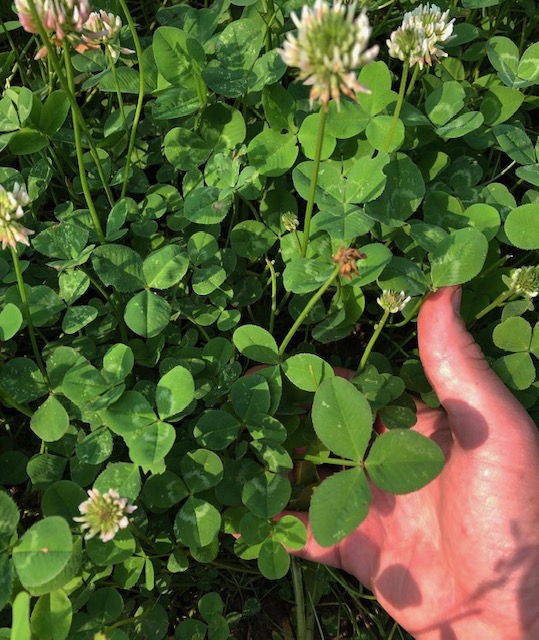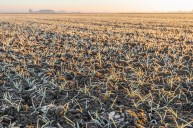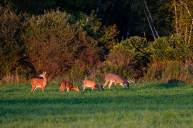We all know the advantages of having food plots on your hunting property. Even if there are ag fields on or around your property, having food plots with a variety of different plant species can really take your hunting to the next level.
But what if you don't have the luxury of owning massive tractors, roto-tillers, and disc attachments? There is still a great option for you to get your plots in before the season starts, and they are called "No-Till Plots."
What is a No-Till Food Plot?
No-till food plots are just what they sound like: food plots planted for game animals (most typically whitetail deer) that do not require any heavy machinery or costly farming accessories to actively till the soil to prepare it for planting. No-till plots require less work overall but can still attract deer as well as a plot meticulously tilled with expensive heavy equipment.
These types of plots offer a great way to maximize the food you have on your property. In fact, I have several pieces of large farm equipment and I still choose to put in around four or five no-till plots on my property every year. Not only are they slightly easier to create, but they also add benefits to your soil.
Without constantly discing and breaking apart the ground, you're building a healthy top layer of soil, which will create better germination and healthier plots all together. While using a roto-tiller and a disc have their benefits, using them too much can cause soil erosion and rid your soil of some of the key nutrients it needs to produce healthy vegetation.
Using the No-Till Method

Effectively using the no-till method can require a little bit of elbow grease, but with the right gear and preparations, it can be done and produce great results. The one step that you should never skip, especially on a no-till food plot, is getting a soil test done. There are tons of websites that will send you a packet for you to put your soil in, with a shipping label already stamped on for easy service. Pretty much any local farm supply store or co-op will have products and the ability to help send your soil sample in to get the analysis. It's important to know the acidity level as well as what nutrients your soil might be lacking. This may require some added costs such as fertilizer or lyme, but trust me, it will be worth it.
The next step will be to clear out any existing vegetation, and the most common way to do this is through weed killer. More specifically, the best way is with glyphosate or Round-Up. This can be effectively administered with a $200-or-less backpack sprayer, but if you're looking to save time, Chapin and Fimco make great sprayers that will attach to an ATV, which will make spraying your plot a breeze.
Finally, you'll want to broadcast your seed with a good spreader, ensuring that you have ideal seed-to-soil contact. For my no-till plots, I like to use food plot seeds that I know have a good germination rate, but they also need to prove that they attract and hold deer. A hand spreader
I have found that during the spring, nothing beats clover. It grows quickly, can withstand heavy feeding from deer, and will also attract turkeys too, if that's your thing. For late season, nothing beats brassicas such as turnips and radishes. They can pretty much grow anywhere and are tolerant to all types of solid. Another great option for late season would be to plant oats. They need a little more seed-to-soil contact, but I have had great luck getting them properly planted with a pull-behind ATV cultipacker. In a pinch, even the tires of your ATV will do if you're on a budget.
No-Till Food Plot Location
You can effectively put a no-till food plot anywhere on your property, assuming there is good sunlight, no flooding, and the soil is healthy (be sure to get your soil test done before spending any time or resources planting). Throughout the years working on my farm, I have found that there are definitely more ideal spots to put a no-till plot than I first anticipated.
To help narrow it down, I'll explain two of my favorite food plot locations, and how they play into my hunting strategy.
First of all, I absolutely love planting "The Kill Plot." This might be my favorite food plot strategy, as it is typically inexpensive, doesn't require as much work in its early stages, and is extremely effective. I'm sure some people have their own definition of what a kill plot should be, but mine goes like this: Generally speaking, if a buck is anywhere in the food plot, he will be in range for me to kill. Even if I can only clear out a spot that's 20 feet by 20 feet, I'll plant something that will withstand heavy grazing such as clover, chicory, and a late season food source such as radishes and turnips. It's the sort of mixture that will keep bucks coming back to paw at the bulbous roots throughout the season. This can make for incredible "staging areas," where a buck will come visit before sunset, just before he transitions to a big ag field at night.
The other technique I love involves planting no-till plots in hard-to-reach spots. Sometimes, there's a small clearing deep into the woods that would be impossible to get a tractor into, but would make for a good food plot. Should you just leave it dormant? Absolutely not. This is the perfect opportunity to go in with an ATV or on foot, broadcast some buckwheat or winter rye seed, and watch as the deer congregate towards this secluded food source without any tilling efforts on your part.
Overall, no-till food plots are a great option to use whether you're on a budget, crunched for time, or maybe just trying to rebuild the top soil on your land and prevent erosion. With a little bit of sweat equity, strategic hand tools, and some planning, you can have the food plot of your dreams that will attract and hold deer all season long.
Products featured on Wide Open Spaces are independently selected by our writers and editors. However, when you buy something through our links, we may earn a commission.
READ MORE: 7 BEST FULL BODY DEER DECOYS THAT PULL BIG BUCKS TO YOUR STAND





